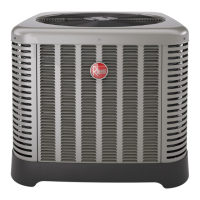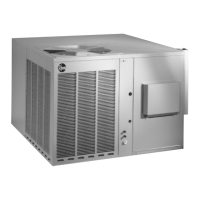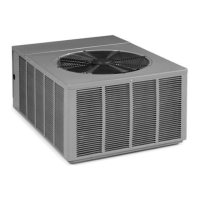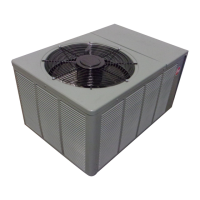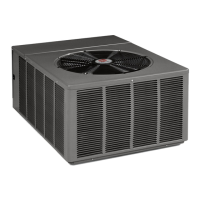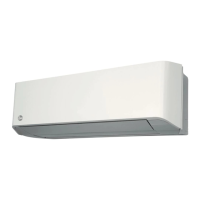32
The controls found in the (-)A18AZ/(-)P18AZ heat
pumps are designed to prevent the system from
operating in under conditions that could be harmful to
the compressor and inverter. The Universal Outdoor
Control (UODC) and Power Inverter continuously
monitor multiple sensors, current, and voltage and will
modify the compressor speed or completely shut the
system down to protect the compressor and/or inverter
if harmful operating conditions are sensed. This
process is called Active System Protection. Sections
8.1 – 8.14 give a brief description of the different forms
of protection that are provided. Refer to Section 9.5
in the Diagnostic and Troubleshooting Section of this
manual for Active System Protection fault codes and
additional details for each fault.
8.1 Minimum Run Timer
A minimum run time of 30 seconds is maintained by the
UODC to minimize short cycling which can be harmful
to the compressor.
8.2 Oil Return Cycle
When the system has been operating at significantly
reduced capacity for an extended period of time, the
Universal Outdoor Control (UODC) will signal the
Inverter to speed the compressor up to 100% capacity
to help bring any oil that has accumulated in the indoor
coil and refrigerant lines back to the compressor sump.
8.3 O-Cycle Refrigerant
Migration – Stator Heat
Refrigerant can migrate to a cold compressor during
the off cycle which can dilute the oil or result in the oil
being pumped out when the compressor starts. When
needed, the UODC will signal the inverter to energize
one of the compressor stator windings (Stator Heat)
to generate enough heat to warm the compressor to
prevent refrigerant migration to the compressor or
boil off any refrigerant that may have migrated to the
compressor.
8.4 High Discharge Temperature
The Power Inverter continuously monitors the
Discharge Line Thermistor input to protect the
compressor should the discharge temperature reach an
unsafe level. If the discharge line temperature rises to
235°F [113ºC], the Inverter will reduce the compressor
RPM incrementally until the temperature drops to
200°F [93ºC]. After the discharge temperature
reaches 200°F [93ºC], the Inverter will gradually
increase the compressor RPM until the compressor
returns to normal speed based on the capacity
demand. Should the discharge temperature rise to
235°F [113ºC] again, the Inverter to repeat the speed
reduction cycle to maintain a temperature below 235°F
[113 ºC].
8.5 High Discharge Pressure
The High Pressure Control (HPC) limits the compressor
discharge pressure to a safe level to prevent damage
to the compressor. When the HPC contacts open at
610 PSIG [4206 kPa], the compressor will proceed
to shut down and restart per the sequence shown
below. If the HPC contacts open three (3) times during
the same call for operation, the UODC will lock the
compressor out and will flash a 29L fault code and the
EcoNet
TM
Control Center will display a High Refrigerant
Pressure Lockout fault on the screen. A manual reset
is required for the UODC to exit the compressor lock-
out mode and clear the fault. This is accomplished by
disconnecting the electrical power to both the indoor
and outdoor units for 1 minute and then reconnecting
power.
NOTE: If the system experiences a high refrigerant
pressure lock-out, the system should be evaluated
to determine the cause for the high pressure
condition and corrective action taken to eliminate
the cause. Possible causes include excessive
refrigerant charge, a failed indoor blower motor,
dirty return air filter, or a dirty indoor coil (heating
mode) or excessive refrigerant charge, a failed
outdoor motor, or dirty outdoor coil (cooling
mode).
8.6 Low Suction Pressure
/
Loss of Charge
The Universal Outdoor Control (UODC) continuously
monitors the Suction Pressure Transducer input and
will protect the compressor from damage by shutting
it down when the suction pressure drops below 50
PSIG [345 kPa] in the cooling mode and below 15
PSIG [103 kPa] in the heating mode. A low pressure
condition can result from inadequate indoor air-flow,
low refrigerant charge, failed EXV, or a restriction in the
refrigerant circuit. The UODC will allow the compressor
to restart if the suction pressure rises to 95 PSIG [655
kPa] in the cooling mode and 40 PSIG [276 kPa] in
the heating mode. A low refrigerant pressure fault
will be ignored for the first 90 seconds of compressor
operation and during the entire defrost cycle to
eliminate nuisance faults.
If there are 3 low pressure faults in the same call for
cooling or during 120 minutes of continuous heating
operation, the UODC will lock the compressor out and
flash a 21L fault code and the EcoNet
TM
Control Center
will display a Low Refrigerant Pressure Lockout fault
on the screen. If the outdoor ambient is below -10°F
[-23°C] in the heating mode when the lockout occurs,
the control will automatically reset when the outdoor
ambient rises to -10°F [-23°C]. If the outdoor ambient
is above -10°F [-23°C], a manual reset is required for
the VSODU to exit the compressor lock-out mode and
8.0 ACTIVE SYSTEM PROTECTION FEATURES
System Protection
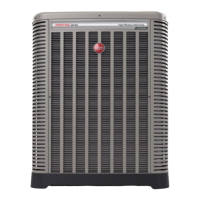
